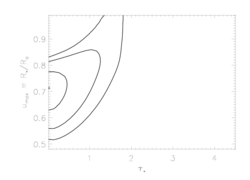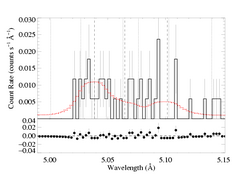S XV 5.0387, 5.0648, 5.1015 Angstroms
Non-porous models
Note: Both MEG and HEG are being fit simultaneously. See the fitting log. We used the hewind model, which fits the three components with separate wind profile models in which the relevant parameters are tied together, including the radius-dependent relative emissivities of the forbidden and intercombination lines. In other words, the line ratios and line shapes are self-consistently accounted for.
Continuum fit on 4.7:4.85 and 5.2:5.4. View the spectral region near the line: MEG and HEG. For n=2, best-fit norm=6.38e-4. The 68% confidence limits on the normalization are +/- 1.e-4. And the best fit is formally a good fit (though only barely; with a 95% rejection probability).
Here are the 68%, 90%, and 95% joint confidence limits on taustar and uo. The asterisk represents the best-fit model, shown as the red histograms on the above plot.

|
No constraints can be put on the porosity length when fitting porous line profile models.
Back to main page.
last modified: 15 October 2008

